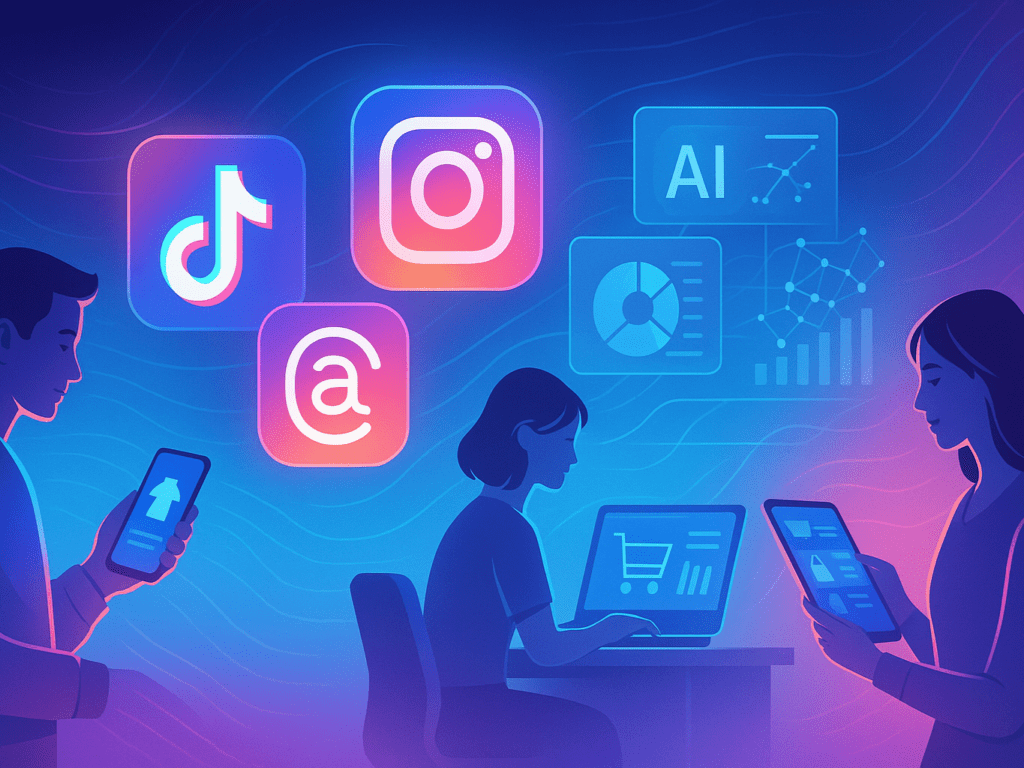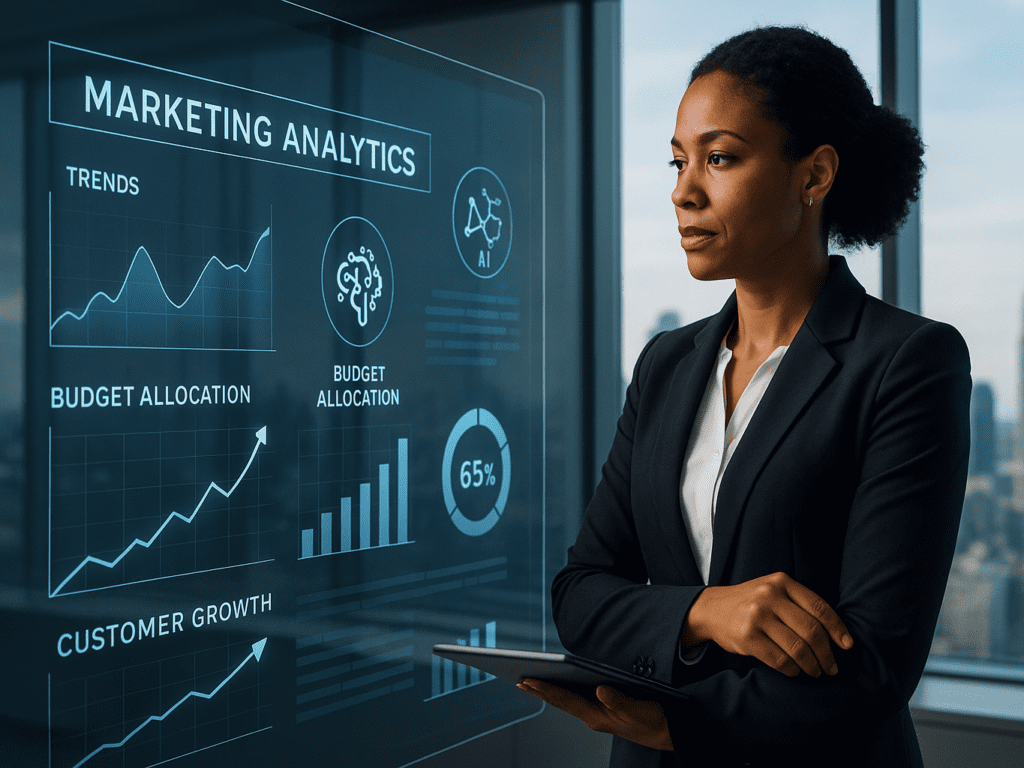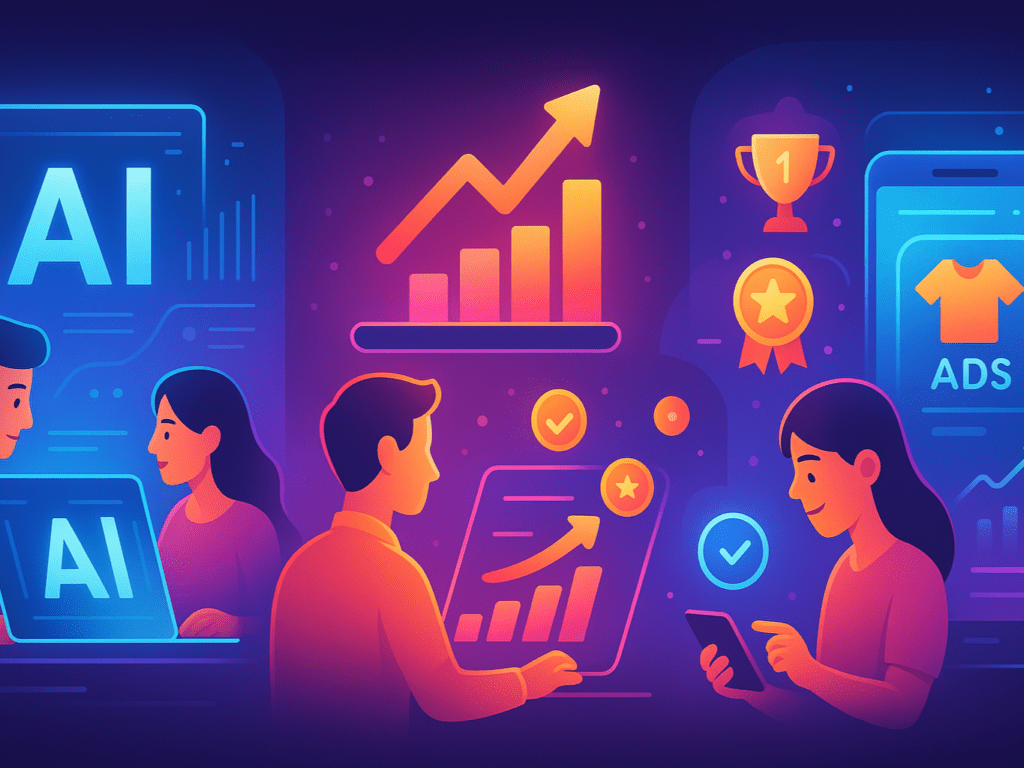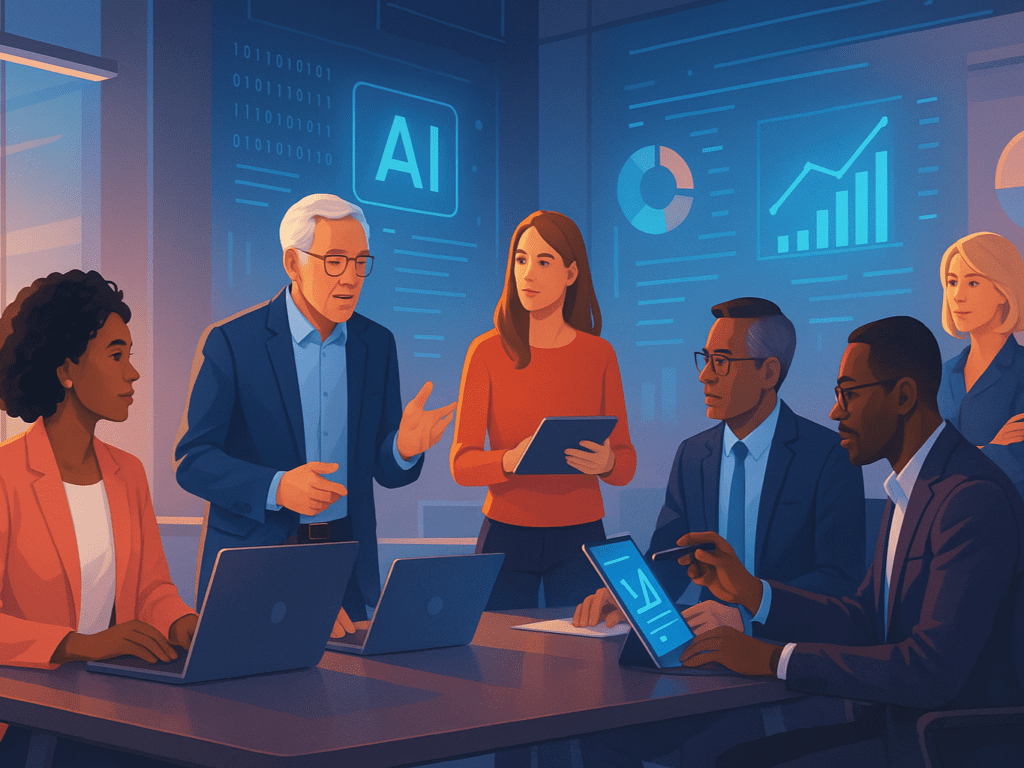Marketing budgets are expected to tighten in 2024, but performance expectations remain high. Teams must deliver better results with fewer resources. Digital marketing trends for 2025 point toward innovative AI solutions, with 54% of marketers now using AI, a substantial increase from 37% last year.
These emerging marketing trends reshape customer engagement strategies. Recent data reveals compelling insights: 75% of customers want tailored content. Voice search has become increasingly crucial, as 51% of consumers research products online. The creator economy is projected to reach a value of $480 billion by 2027.
Success in marketing for 2025 relies on identifying trends that generate real impact. This piece examines the proven digital marketing strategies employed by leading Chief Marketing Officers (CMOs). From AI-powered campaigns to community-led growth initiatives, you’ll learn where to allocate your resources effectively.
What’s Changing in Digital Marketing Trends Right Now
The digital world has undergone rapid change over the past year. Brands now connect with their audience in new ways as technology reshapes traditional marketing methods. Let’s explore three significant changes shaping Digital marketing trends in 2025.
1. Social platforms are replacing traditional media.
Social media has taken over traditional marketing channels. These platforms now serve as comprehensive marketing ecosystems, rather than just promotional tools.
The rise of platforms is happening faster:
- TikTok leads with 1.5 billion monthly active users, which makes marketers adapt to short-form video content
- Threads gained 150 million users in under a year and opened new ways for text-based interaction
- Vertical video makes up over 60% of digital video consumption on all platforms
This change affects more than just audience attention. A CNN report indicates that media budgets are now shifting toward social platforms, while TV and print advertising are declining. The numbers tell the story: 79% of Gen Z finds new brands through social media rather than traditional ads.
Social platforms have evolved into comprehensive shopping ecosystems. Instagram, TikTok, and Pinterest now offer in-app buying options that blur the lines between content and commerce.
2. AI tools are becoming everyday essentials.
AI in marketing has moved from theory to practice. Marketing departments of all sizes now use what was just experimental a few months ago.
Marketing teams are adopting AI tools faster across many areas:
- Content creation: AI now writes first drafts for blogs, emails, and social posts
- Campaign optimization: Immediate analytics help marketers predict results and adjust strategies
- Customer segmentation: Machine learning spots patterns humans might miss to target audiences better
Small and medium-sized businesses can now access sophisticated AI marketing tools through affordable Software as a Service (SaaS) platforms. This technology is no longer exclusive to large companies with deep pockets.
Marketing teams have moved past the initial novelty phase of AI. They now integrate AI throughout their workflows, rather than using it for individual tasks. This approach enables marketers to focus on strategy rather than routine tasks.
3. Consumers are shifting how they search and shop
People’s shopping habits keep changing, which creates new challenges and chances for marketers to reach them.
Google no longer dominates product searches. Users start their shopping on:
- Amazon (61% of product searches)
- TikTok (40% of Gen Z users choose it over Google)
- Instagram (76% of users find new products on the platform)
Additionally, voice search continues to grow. Approximately 51% of consumers utilize voice assistants to research products before making a purchase. Marketers must now optimize content for conversational keywords and natural language.
Privacy issues have changed how marketers target ads. Marketers are focusing on first-party data as third-party cookies fade away and privacy regulations become stricter. Building direct customer relationships is now vital for effective marketing.
Modern consumers expect individual-specific experiences throughout their buying process. Generic marketing messages no longer work; 75% of consumers want personalized content and offers. Marketers must strike a balance between personalization and privacy while delivering relevant experiences to a large audience.
Digital marketing trends for 2025 reflect three significant changes: social platforms taking over, AI becoming essential, and new consumer habits, which are the foundations of marketing trends that will define success in 2025 and beyond. Marketers who understand these changes will develop strategies that adapt to the evolving digital landscape.
How CMOs Are Prioritizing 2025 Marketing Trends

Economic uncertainty in 2025 presents CMOs with a challenging decision on where to allocate their limited resources. Smaller budgets and higher stakeholder expectations mean CMOs need more innovative strategies for determining which digital marketing trends to pursue and which to avoid.
1. Balancing innovation with budget constraints
CMOs must strike a balance between cutting-edge technology and smart spending. Research shows that 91% of global tech decision-makers plan to increase their budgets next year, even with challenges like high interest rates and workforce issues.
All the same, this positive outlook brings higher demands to prove value. CMOs have adapted their strategy in several ways:
- Picking fewer, better solutions rather than spreading money across many technologies
- Smart resource allocation to projects with measurable returns
- Faster customer growth through tailored experiences that solve specific problems
Marketing ROI pressure stays high. CNN reports that companies using structured systems for evaluation, approval, and monitoring achieve their targets without incurring significant costs. This reality prompts CMOs to review performance regularly, rather than adopting a “set-it-and-forget-it” approach.
“Proving ROI is vital to secure marketing budget,” states one industry report. Marketing leaders now focus on optimizing their current technology rather than simply purchasing new tools.
AI generates buzz, but not everyone jumps on board. Reports show that AI interest has “skyrocketed” among brand marketers, yet companies adopt it in different ways. Smart CMOs invest in AI tools that improve data quality. They build better foundations for future decisions, rather than chasing technology for its own sake.
2. Choosing trends that match business goals
Marketing strategies must support broader business objectives to secure ongoing investment. This connection defines successful marketing leadership in 2025.
Research suggests a good marketing plan should be “by marketing for the business,” not “by marketing for marketing.” This difference shapes how top CMOs approach Digital marketing trends 2025.
Leading marketers ensure alignment through the following:
- SMART objectives that connect to company goals directly
- Marketing performance checks at least monthly
- Focus on initiatives that boost revenue and growth
Business alignment gets results. Companies with unified sales and marketing teams achieve 38% higher sales win rates and retain 36% more customers. Poor alignment can cost companies 10% or more of their yearly revenue.
Marketing goals should adapt to changing market conditions. “Your marketing plan must evolve as markets shift,” one report explains. This flexibility enables teams to respond to changes while maintaining focus on their core business objectives.
Strategic CMOs bring their teams closer to other departments. Working across functions ensures marketing efforts support company-wide goals rather than standing alone.
NIQ’s CMO Outlook survey reveals that AI advancements foster closer collaboration among marketing, IT, and data teams. This unity enables companies to utilize AI more effectively while aligning their tech investments with business strategy.
“Today’s CMO does more than marketing,” an industry expert points out. “They think strategically, lead innovation, and drive change throughout the business.” This broader role shows marketing’s growing impact on business success in our digital age.
AI in Action: What CMOs Are Using

CMOs are leveraging AI technologies in 2024 with applications that deliver precise results. Research shows that 90% of marketers plan to increase their AI investments in 2025. About 80% say their 2024 AI implementations exceeded expectations in terms of ROI. Let’s explore three AI applications that leading marketers are currently utilizing.
1. AI agents for campaign automation
AI agents are revolutionizing the way marketing campaigns are executed. These agents do more than simple automation tools; they work independently to make decisions and take action without human input.
CMOs use AI agents to:
- Handle repetitive campaign tasks: Studies show that 25% of workers spend half their day doing manual tasks that AI could handle.
- Monitor performance continuously: AI agents assess campaigns using up-to-the-minute data and make quick adjustments.
- Manage cross-channel coordination: They ensure messages are consistent across platforms while maximizing the features of each channel.
“AI agents don’t just speed things up; they make processes smarter,” states an industry report. These systems enhance productivity, expedite campaign launches, and boost ROI when integrated with marketing platforms.
Yum Brands shows this approach in action. The company behind Taco Bell, Pizza Hut, and KFC utilizes AI agents that tailor marketing messages to individual locations, purchasing habits, and specific timing. These agents test and fine-tune email promotions to bring customers back.
2. Generative AI for content and personalization
CMOs are betting on generative AI in 2025 to create personal customer experiences at scale. CNN reports that 71% of consumers now expect personalized content. Approximately 67% become frustrated when interactions fail to meet their needs.
Winning applications include:
- Text generators for marketing copy, product descriptions, and email subject lines
- Image generation for logos, product displays, and custom visuals
- AI-generated video showing products in multiple languages
Companies choose generative AI because it delivers personal experiences while cutting costs. Research shows that AI-powered personalization can boost retail profits by 15% while reducing marketing costs by 20%.
Marketing teams now use these tools throughout their workflow. It helps marketers focus on strategy instead of day-to-day tasks.
3. AI-powered analytics for faster decisions
AI’s most significant contribution to marketing in 2025 stems from its advanced analytics capabilities. CMOs utilize AI-powered analytics to process vast amounts of data and identify patterns, enabling them to make informed decisions faster than ever before.
Key applications include:
- Predictive analytics: Seeing how campaigns might perform before launch
- Real-time optimization: Spotting weak campaigns and moving resources quickly
- Customer journey mapping: Tracking behavior across touchpoints to understand customer experience
“AI-driven data analytics helps ensure that marketing resources are used efficiently,” says an industry expert. AI reveals what works and what doesn’t, enabling businesses to allocate their resources effectively.
It matters even more as marketing budgets stay tight. AI analytics tools help teams achieve the best return on investment (ROI) by identifying the most effective channels and tactics.
These tools have changed the game. Big companies used to be the only ones with access to advanced AI analytics. Now, businesses of any size can use these tools through affordable SaaS platforms. It means marketing teams can get advanced insight, regardless of their organization’s size.
The Rise of Social Commerce and Community-Led Growth
Social platforms are evolving faster than ever. They have moved beyond simple communication tools to become comprehensive commerce ecosystems. This transformation has changed how brands connect with their audiences in 2025. Traditional marketing channels have lost ground, while community-driven involvement has become the lifeblood of Digital marketing trends 2025.
1. Threads, BlueSky, and the fall of traditional influencers
The digital world is witnessing significant shifts as platforms like Threads and BlueSky attract users seeking genuine connections.
Threads has shown fantastic growth. It reached 275 million monthly active users and added 15 million new sign-ups in November 2024 alone. BlueSky now has over 15 million total users. It gained more than a million new users right after the 2024 election.
Users are seeking alternatives to traditional platforms, which explains the rapid growth. Many say BlueSky reminds them of “the early days of Twitter.” The platform has attracted prominent figures such as:
- New York Representative Alexandria Ocasio-Cortez
- Author John Green
- Billionaire Mark Cuban (who marked his entrance with “Hello Less Hateful World”)
Platform dynamics continue to change. Meta plans to enable advertisers to create and publish ads on Threads starting in January 2025. It presents a vital opportunity for marketers seeking to reach audiences on text-based platforms.
These platforms stand out in digital marketing trends 2025 because they value conversation over discovery. TikTok and Instagram push algorithm-driven content discovery. However, Threads and BlueSky let users follow and interact with their chosen accounts.
This structural difference has altered the map of brand content creation. One industry report states, “The microblogging wars are in full effect.” Brands need authentic involvement strategies that build conversation and community instead of traditional influencer marketing.
2. Employee-generated content and customer co-creation
Brands utilize their employees’ and customers’ creativity to make authentic marketing materials. It marks a fundamental change in content creation.
Employee-generated content (EGC) proves to be cost-effective and more effective than traditional brand messages. Forbes reports that companies using EGC saw a 27% increase in online engagement and 19% more sales in their first year.
This strategy brings clear benefits:
- Better trust and authenticity: 88% of consumers say authenticity matters when choosing brands to support
- Lower costs: EGC uses existing talent without paying external creators or production teams
- Better hiring: 86% of job seekers use social media to find jobs
Employee voices and customer co-creation build authenticity and trust. When employees share views, it feels more credible, while involving customers in product development creates stronger brand loyalty. Heineken’s “Open Design Explorations” showed how global collaboration can shape unique brand experiences.
Social commerce is booming, with an expected market value of $1.2 trillion by 2025. Yet trust remains a concern; around 40% of users worry about data privacy. Community-led, authentic content is crucial for success on these rapidly growing platforms.
Search is Evolving: How CMOs Are Adapting SEO Strategies

The search world in 2025 looks radically different from what marketers knew a few years ago. Social media platforms now help one in three people find answers to their questions. 40% of Gen Z users prefer TikTok over Google when they need to find something. Smart CMOs streamline their SEO strategies to stay visible as search behaviors evolve.
1. Social search and voice search optimization
Social platforms have grown beyond simple communication tools into powerful search engines. Adobe’s research indicates that more than two in five Americans use TikTok as a search engine. Gen Zers are particularly interesting; 1 in 10 turn to TikTok before Google for searches. Marketing leaders must develop distinct strategies for each platform.
Marketing leaders utilize these strategies to optimize for social search:
- Keyword research specifically for social platforms: Users tend to search more conversationally and informationally on social media rather than making transactions
- Platform-specific content optimization: Each platform needs its own approach, from Instagram alt text to YouTube chapter titles
- Location tagging: Geographic details help content show up in local social search results
Voice search has become a game-changer. Two out of ten Google searches happen through voice commands. It changes how people interact with search engines.
“Voice search queries are usually more conversational, longer, and formulated as full sentences or questions,” notes one industry report. People now ask, “Hey Siri, can you find an Italian restaurant nearby?” instead of typing, “Italian restaurants near me.”
CMOs adapt to conversational search through:
- Question keywords starting with “how,” “what,” “why,” “when,” and “where”
- Long-tail keywords that match natural speech
- Fast-loading websites that rank well in both voice and traditional search
2. Generative Engine Optimization (GEO) explained.
AI-powered search engines revolutionize the search landscape. CNN reports that these platforms blend traditional search functionality with the power of generative AI.
Generative Engine Optimization (GEO) helps content rank better in AI-driven search engines, such as ChatGPT, Perplexity, Gemini, Copilot, and Google AI Overviews. This approach becomes increasingly vital as AI reshapes the way information is discovered and consumed.
GEO differs from traditional SEO in these ways:
- Focus on conversational relevance: AI engines value detailed answers over keyword density.
- Context over keywords: AI models look at content’s broader meaning, not just keywords
- Quality over quantity: E-E-A-T principles (expertise, experience, authoritativeness, and trustworthiness) matter more in GEO
“While traditional SEO focuses on keywords, link-building, and other ranking factors to boost a website’s position on SERPs, GEO requires a deeper understanding of AI’s role in content generation,” explains one industry expert.
GEO shows promising results. Brands on Google’s first page correlate strongly (about 0.65) with mentions in large language models. Quality content works well for both traditional and AI search algorithms.
Marketing leaders now focus on:
- Explicit, relevant content that AI systems understand easily
- Structured data that helps AI grasp content context better
- Strong technical SEO foundations that work across all search types
The boundaries between traditional, social, and AI-powered search blur through 2025. Success comes to CMOs who adapt to this complex search ecosystem while creating quality content.
Content That Converts: What’s Working in 2025

Content that drives conversions needs both innovative techniques and proven strategies in 2025. The Digital marketing trends 2025 show more technological sophistication, yet storytelling fundamentals remain crucial. The application of these fundamentals makes all the difference.
1. Combining AI and human creativity
Success in content marketing during 2025 depends on mutually beneficial alliances between AI tools and human creativity. CNN reports that companies that blend AI capabilities with human insight achieve 30% higher engagement rates than those that rely solely on one approach. This model works because:
- AI excels at data analysis, personalization, and content optimization
- Humans provide emotional intelligence, cultural awareness, and strategic thinking
- The combination creates content that resonates both analytically and emotionally
Successful brands use AI to amplify human creativity rather than replace it. It works exceptionally well with short-form content. Sixty-five percent of marketers report that AI-assisted social posts perform better than human-only content in terms of engagement and conversion rates.
2. Refreshing old content for new results
Content updates have become a powerful strategy. Search algorithms now favor fresh and detailed content more than ever. Updated content delivers:
- 74% higher traffic compared to new content
- 52% increase in conversion rates with current data updates
- 116% improvement in organic visibility when content combines and improves
Marketing teams achieve maximum results through the following:
- Analytics help identify high-potential content
- Statistics and examples get updates
- Current keywords and search intent boost relevance
- Multimedia elements improve engagement
3. Targeting Gen Alpha with gamified content
Generation Alpha, born between 2010 and 2025, represents the first digital-native audience. Successful brands connect with this demographic through gamification, turning passive content into interactive experiences.
Gamified content includes:
- Achievement systems (badges, points, rewards)
- Competition elements (leaderboards, challenges)
- Interactive storytelling with choice-based narratives
Gamified marketing campaigns exhibit 48% higher engagement and 22% improved conversion rates compared to traditional content. Brands that incorporate AR/VR elements into their gamified content achieve remarkable results. User attention spans jump from 8 seconds to over 75 seconds per interaction.
Combining AI-human collaboration, content refreshing, and gamification enables marketers to create content that drives conversions in today’s competitive digital landscape.
Personalization at Scale: Turning Data into Loyalty
In 2025, customers expect tailored experiences, with 71% demanding personalization and 76% feeling frustrated when brands fail to deliver. The best Digital marketing trends 2025 create these personalized moments at scale and build customer loyalty through evidence-based interactions.
1. Using first-party data for hyper-targeting
First-party data, information collected directly from your audience, has become the lifeblood of effective personalization strategies. CNN reports that brands using first-party data through loyalty programs see 30% higher engagement rates than those depending on third-party sources.
This change toward first-party data brings several benefits:
- Better accuracy: Direct data collection gives more reliable customer insights than third-party sources
- Privacy compliance: First-party data collection fits with regulations like GDPR and CCPA
- Better customer understanding: Analysis of behavior across channels shows patterns and priorities
Companies typically centralise customer data from multiple sources into unified profiles through Customer Data Platforms (CDPs). These platforms help segment audiences based on behaviors and priorities, creating targeted campaigns that resonate with specific customer groups.
2. Dynamic content and predictive recommendations
Dynamic content adapts automatically based on user data, priorities, and behaviors. It adjusts live to boost relevance. This method turns generic experiences into personalized trips.
The results are significant:
- In the awareness stage, dynamic content aligns with user intent and guides them through the next steps. For instance, dynamic search ads pull copy directly from landing pages to create ads matching specific search terms.
- During consideration, dynamic content builds trust through personalized emails and website experiences. Studies show that personalization can increase retail profits by 15% while cutting marketing costs by 20%.
We now use the most advanced personalization strategies, incorporating predictive analytics to anticipate customer needs. Brands can forecast individual priorities by analyzing past interactions, purchases, and web activity, letting them offer solutions before customers express their needs.
Upskilling Teams for the Future of Digital Marketing

The marketing skills needed to utilize technology effectively change rapidly as marketing technologies evolve. The American Marketing Association’s 2025 Skills Report shows that 43% of marketers identify generative AI as their most crucial skill for the next five years. Significant skill gaps exist in digital marketing and data analytics.
1. AI fluency and prompt engineering
Marketing teams must become fluent in AI applications. “AI will completely change how we do marketing,” says Laura Curtis Ferrera, global CMO at Scotiabank. Innovative marketing leaders prioritize AI experiments daily by:
- Launching cross-functional AI task forces that speed up marketing strategy integration
- Identifying specific processes where AI agents add value
- Learning low-code platforms like HubSpot’s Agent.ai that don’t need coding expertise
Prompt engineering has become increasingly valuable, particularly when crafting effective instructions for AI tools. CNN reports that marketers who excel at prompt engineering create content 67% faster while maintaining high quality. This skill requires knowing how to:
- Establish proper context for AI-generated outputs
- Provide accurate input data for meaningful results
- Define appropriate output formats and structures
2. Soft skills and cross-functional knowledge
The 2025 AMA Marketing Skills Report emphasizes that human skills remain vital, particularly in areas such as communication, creativity, and adaptability. These capabilities help marketers in today’s AI-driven environment to:
- Connect emotionally with audiences in ways AI cannot
- Guide changes in technology and consumer behavior
- Develop innovative approaches to marketing challenges
Cross-functional knowledge matters equally as marketing merges with IT, data science, and product development. Marketing organizations streamline this reality by:
- Organizing multidisciplinary pods instead of siloed teams
- Creating overlapping responsibilities that break down “that’s not my job” mindsets
- Building clear communication channels between specialized groups
The most successful marketing teams in 2025 strike a balance between AI expertise and strong human capabilities. One expert refers to these individuals as “T-shaped marketers,” who combine in-depth expertise in a specific area with broad knowledge across multiple disciplines.
Final Thoughts
Digital marketing trends in 2025, such as AI adoption, social commerce growth, and shifting consumer behaviors, are reshaping digital marketing through 2025. CNN reports that companies that blend AI capabilities with human insight effectively achieve 30% higher involvement rates than those using either approach alone.
Success in marketing by 2025 depends on these essential elements:
- AI fluency balanced with human creativity
- Authentic community-driven content development
- Search behavior adaptation on different platforms
- Customized content using first-party data
- Team training for new technologies
Your marketing results depend on picking the right trends while monitoring measurable outcomes. The first step is to identify which trends align with your business goals, and then build a well-laid-out implementation plan. Strategic adoption matters more than following every new trend.
Delivering value to your audience should remain your top priority. Technologies and platforms evolve, but connecting meaningfully with customers is still fundamental. Marketers who become skilled in both technical capabilities and human-centred principles will lead the way.




